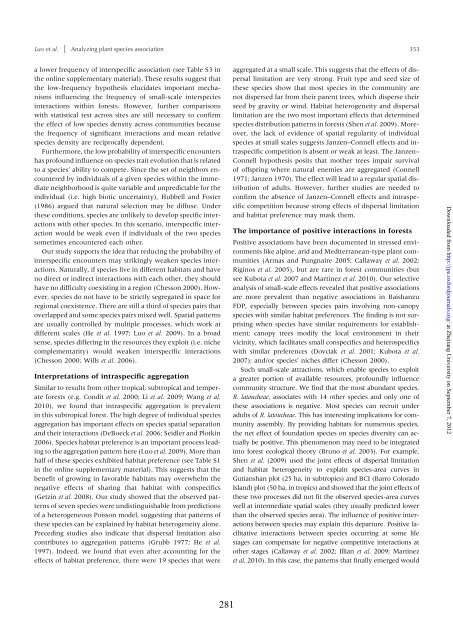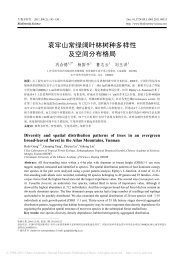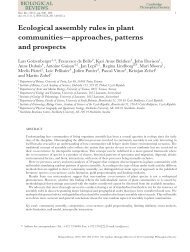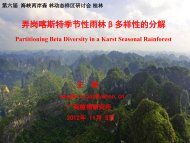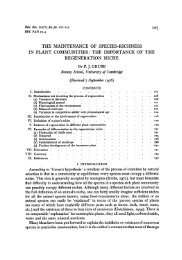Contents - ä¸å½æ£®æçç©å¤æ ·æ§çæµç½ç»
Contents - ä¸å½æ£®æçç©å¤æ ·æ§çæµç½ç»
Contents - ä¸å½æ£®æçç©å¤æ ·æ§çæµç½ç»
- No tags were found...
Create successful ePaper yourself
Turn your PDF publications into a flip-book with our unique Google optimized e-Paper software.
8Luo et al. | Analyzing plant species association353Journal of Plant Ecologya lower frequency of interspecific association (see Table S3 inthe online supplementary material). These results suggest thatthe low-frequency hypothesis elucidates important mechanismsinfluencing the frequency of small-scale interspeciesinteractions within forests. However, further comparisonswith statistical test across sites are still necessary to confirmthe effect of low species density across communities becausethe frequency of significant interactions and mean relativespecies density are reciprocally dependent.Furthermore, the low probability of interspecific encountershas profound influence on species trait evolution that is relatedto a species’ ability to compete. Since the set of neighbors encounteredby individuals of a given species within the immediateneighborhood is quite variable and unpredictable for theindividual (i.e. high biotic uncertainty), Hubbell and Foster(1986) argued that natural selection may be diffuse. Underthese conditions, species are unlikely to develop specific interactionswith other species. In this scenario, interspecific interactionwould be weak even if individuals of the two speciessometimes encountered each other.Our study supports the idea that reducing the probability ofinterspecific encounters may strikingly weaken species interactions.Naturally, if species live in different habitats and haveno direct or indirect interactions with each other, they shouldhave no difficulty coexisting in a region (Chesson 2000). However,species do not have to be strictly segregated in space forregional coexistence. There are still a third of species pairs thatoverlapped and some species pairs mixed well. Spatial patternsare usually controlled by multiple processes, which work atdifferent scales (He et al. 1997; Luo et al. 2009). In a broadsense, species differing in the resources they exploit (i.e. nichecomplementarity) would weaken interspecific interactions(Chesson 2000; Wills et al. 2006).Interpretations of intraspecific aggregationSimilar to results from other tropical, subtropical and temperateforests (e.g. Condit et al. 2000; Li et al. 2009; Wang et al.2010), we found that intraspecific aggregation is prevalentin this subtropical forest. The high degree of individual speciesaggregation has important effects on species spatial separationand their interactions (DeBoeck et al. 2006; Seidler and Plotkin2006). Species habitat preference is an important process leadingto the aggregation pattern here (Luo et al. 2009). More thanhalf of these species exhibited habitat preference (see Table S1in the online supplementary material). This suggests that thebenefit of growing in favorable habitats may overwhelm thenegative effects of sharing that habitat with conspecifics(Getzin et al. 2008). Our study showed that the observed patternsof seven species were undistinguishable from predictionsof a heterogeneous Poisson model, suggesting that patterns ofthese species can be explained by habitat heterogeneity alone.Preceding studies also indicate that dispersal limitation alsocontributes to aggregation patterns (Grubb 1977; He et al.1997). Indeed, we found that even after accounting for theeffects of habitat preference, there were 19 species that wereaggregated at a small scale. This suggests that the effects of dispersallimitation are very strong. Fruit type and seed size ofthese species show that most species in the community arenot dispersed far from their parent trees, which disperse theirseed by gravity or wind. Habitat heterogeneity and dispersallimitation are the two most important effects that determinedspecies distribution patterns in forests (Shen et al. 2009). Moreover,the lack of evidence of spatial regularity of individualspecies at small scales suggests Janzen–Connell effects and intraspecificcompetition is absent or weak at least. The Janzen–Connell hypothesis posits that mother trees impair survivalof offspring where natural enemies are aggregated (Connell1971; Janzen 1970). The effect will lead to a regular spatial distributionof adults. However, further studies are needed toconfirm the absence of Janzen–Connell effects and intraspecificcompetition because strong effects of dispersal limitationand habitat preference may mask them.The importance of positive interactions in forestsPositive associations have been documented in stressed environmentslike alpine, arid and Mediterranean-type plant communities(Armas and Pungnaire 2005; Callaway et al. 2002;Riginos et al. 2005), but are rare in forest communities (butsee Kubota et al. 2007 and Martinez et al. 2010). Our selectiveanalysis of small-scale effects revealed that positive associationsare more prevalent than negative associations in BaishanzuFDP, especially between species pairs involving non-canopyspecies with similar habitat preferences. The finding is not surprisingwhen species have similar requirements for establishment;canopy trees modify the local environment in theirvicinity, which facilitates small conspecifics and heterospecificswith similar preferences (Dovciak et al. 2001; Kubota et al.2007); and/or species’ niches differ (Chesson 2000).Such small-scale attractions, which enable species to exploita greater portion of available resources, profoundly influencecommunity structure. We find that the most abundant species,R. latoucheae, associates with 14 other species and only one ofthese associations is negative. Most species can recruit underadults of R. latoucheae. This has interesting implications for communityassembly. By providing habitats for numerous species,the net effect of foundation species on species diversity can actuallybe positive. This phenomenon may need to be integratedinto forest ecological theory (Bruno et al. 2003). For example,Shen et al. (2009) used the joint effects of dispersal limitationand habitat heterogeneity to explain species-area curves inGutianshan plot (25 ha, in subtropics) and BCI (Barro ColoradoIsland) plot (50 ha, in tropics) and showed that the joint effects ofthese two processes did not fit the observed species-area curveswell at intermediate spatial scales (they usually predicted lowerthan the observed species area). The influence of positive interactionsbetween species may explain this departure. Positive facilitativeinteractions between species occurring at some lifestages can compensate for negative competitive interactions atother stages (Callaway et al. 2002; Illian et al. 2009; Martinezet al. 2010). In this case, the patterns that finally emerged wouldDownloaded from http://jpe.oxfordjournals.org/ at Zhejiang University on September 7, 2012281


